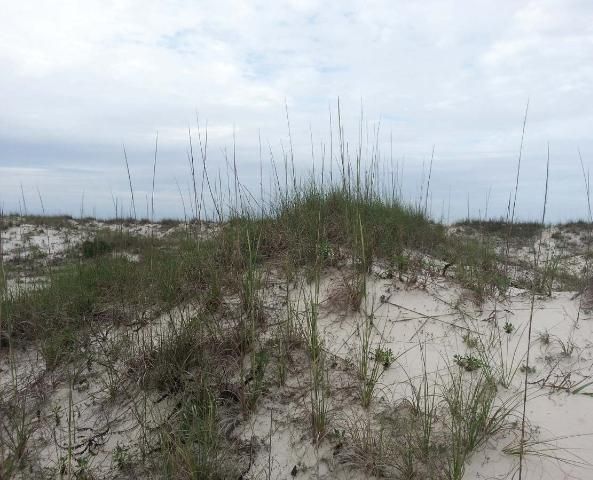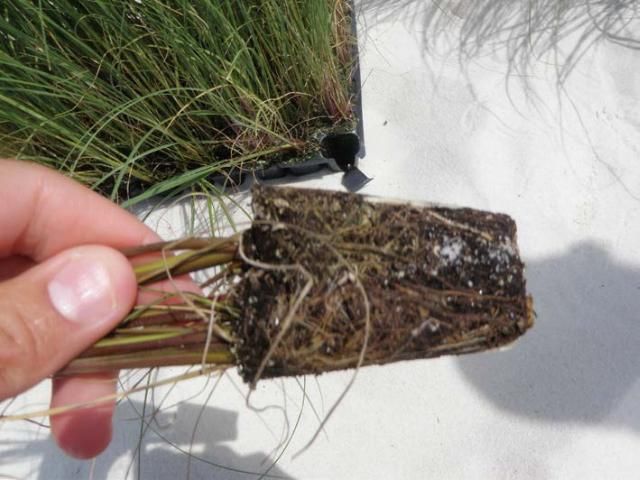Note: This fact sheet is also available as a chapter in a comprehensive manual titled Dune Restoration and Enhancement for the Florida Panhandle, available in pdf form here: https://edis.ifas.ufl.edu/pdffiles/SG/SG15600.pdf. Please see the manual for more information about other useful and attractive native plants for dunes and for further information about restoration and preservation techniques.
Poaceae

Credit: Josiah Raymer, UF/IFAS
Sea oats occur throughout Florida on beach dunes and beaches and on coastal areas west to Texas and north to Maryland. Sea oats are vital dune builders that accumulate sand and prevent erosion due to wind, waves, and large storms. As sand is trapped by the long leaves of sea oats, vertical growth is stimulated, and rooting occurs at the buried nodes. This plant is extremely drought- and salt-tolerant, grows up to the high tide line of beaches, and propagates both vegetatively and by seed in the wild (Shadow 2007).
General Description
Sea oats are perennial grasses that form large colonies by extending culms upright and forming glabrous horizontal rhizomes as sand accumulates around the culms. Leaves are flat, involute at tips, up to 24 in long and 10 mm wide, and have ligule hairs up to 5 mm long. Inflorescences initiate in late spring with a single inflorescence elongating from an individual culm. Inflorescences rise above the leaves in summer, and florets of the inflorescences mature by early fall. Flowering culms reach heights of 6 ft or more and terminate in open panicles of nodding, laterally compressed, arching spikelets that become the color of straw as the outer glumes mature. Florida law prohibits the collection of sea oats inflorescences without a permit. Fruits are caryopses, and although inflorescences are present in late summer, the seed do not fully develop until fall. Sea oats produce very few seed within the large panicles, but the seed that are produced are generally viable.
Propagation
It is illegal to collect sea oats for any reason in the wild without proper permitting. Sea oats can readily be propagated from seed and rhizome fragments. When growing sea oats, minimal fertilizer and irrigation inputs is encouraged (Bachman and Whitwell 1995).
Sea oats rhizomes uprooted by hurricanes and deposited on top of soil can be salvaged as planting material within 3 days after the hurricane and stored for an initial 8 days with sufficient moisture before being planted in pots or the ground (Miller et al. 2003).
Germination of sea oats seeds has been well studied for decades. For Florida Panhandle populations, sea oats seeds require a period of cold stratification before germination, however southern Florida populations lose such requirements (Pérez and Kane 2016; Senaca 1972). Dormancy in Florida Panhandle sea oats can be broken by cold stratification for 15 to 30 days at 40°C (Senaca 1972). Near 100% germination of Florida Panhandle sea oats is possible with a 35/18°C diurnal fluctuation (Senaca 1972). A North Carolina population of sea oats seeds preferred fluctuating temperatures to constant temperatures (Burgess et al. 2002). Photoperiod neither enhances nor suppresses sea oats seed germination (Burgess et al. 2002; Senaca 1972). Sea oats seeds can be stored in airtight jars at room temperature (Nabukalu and Knott 2013) or in a refrigerator (~5°C) (Pérez and Kane 2016) for at least a year without significant loss of seed viability.
Plants grown from seed have been successfully propagated in a nursery setting under a shadehouse. The following protocol was developed by Bachman and Whitwell (1995). Place seeds (2 seeds per cell) 1 in deep within 40-cell flats with a 1:1 volume mix of peat moss and perlite. Immediately drench with fungicide (Banrot) and fertilize at recommended nursery-production rates (Bachman and Whitwell 1995). Transfer seedlings to 1-gal nursery containers with a 4:1 volume mix of pine bark and sand. Containerized plants require fertilizer and have been produced with twice-weekly liquid fertilization while others have used slow-release fertilizers at the standard gallon nursery production rates as recommended by the fertilizer manufacturer. When transplanting to containers it is important to place plants with their crowns even with the surface of the production substrate. While growing in containers, plants may require frequent irrigation.
Outplanting
Sea oats have been successfully outplanted with over 70% survival after 1 year when planted in monoculture or in conjunction with 3 other native beach dune plants (Miller et al. 2001; Stoddard et al. 2014). Transplants were seedlings grown with 4 in rootballs (Miller et al. 2001; Stoddard et al. 2014). Recent work by Hooton et al. (2014) has demonstrated a potential to enhance sea oats establishment and seedling maturation. Hooton demonstrated that wheat straw used as a surrogate wrack increased plant vigor, increased inflorescence production, and increased sand accumulation over a 2-year period compared to conventional planting without a surrogate wrack. Sea oats roots grow in mutualism with fungi that enhance their access to nutrients and moisture in the soil. Nursery production may be enhanced by the use of potting media inoculated with vesicular-arbuscular mycorrhizal fungi (Glomus sp.) (Sylvia and Burks 1988). Seedlings grown in a nursery inoculated with vesicular-arbuscular mycorrhizal (Glomus sp.) fungi had enhanced outplanting success across Florida beaches compared to noninoculated plants (Sylvia 1989).

Credit: Mack Thetford, UF/IFAS
Literature Cited
Bachman, G.R., and T. Whitwell. 1995. "Nursery production of Uniola paniculata (southern seaoats)." HortTechnology 5(4)295:298
Burgess, T., F. Blazich, and D. Nash. 2002. "Seed germination of southern seaoats (Uniola paniculata) as influenced by stratification, temperature, and light." Journal of Environmental Horticulture 20(3):180–183.
Hooton, N., D.L. Miller, M. Thetford, and S.B. Claypool. 2014. "Survival and growth of planted Uniola paniculata and dune building using surrogate wrack on Perdido Key Florida, USA." Restoration Ecology 22(5):701–707.
Stoddard, M., D.L. Miller, L.C. Branch, and M. Thetford. 2014. "Endangered beach mouse: Linking population studies/habitat restoration to predict sea level rise." Final Report submitted to Gulf Islands National Seashore, Gulf Coast Cooperative Ecosystems Studies Unit Project H5000 02 A271. 130 p.
Miller, D.L., M. Thetford, and L. Yager, 2001. "Evaluation of sand fence and vegetation for dune building following overwash by Hurricane Opal on Santa Rosa Island, Florida." Journal of Coastal Research 17(4):936–948.
Miller, D.L., L. Yager, M. Thetford, and M. Schneider. 2003. "Potential use of Uniola paniculata rhizome fragments for dune restoration." Restoration Ecology 11(3):359–369.
Nabukalu, P., and C. Knott. 2013. "Effects of seed storage environment on sea oats (Uniola paniculata)." Ecological Restoration 31(1):16–19.
Pérez, H.E., and M.E. Kane. 2016. "Different plant provenance same seed tolerance to abiotic stress: implications for ex situ germplasm conservation of a widely distributed coastal dune grass (Uniola paniculata L.)." Plant Growth Regulation 82(1):123–137.
Senaca, E.D. 1972. "Germination and seedling response of Atlantic and Gulf Coast populations of Uniola paniculata." American Journal of Botany 59(3):290–296.
Shadow, R. 2007. "Plant fact sheet for sea oats (Uniola paniculata L.)." USDA NRCS, East Texas Plant Material Center. United States Department of Agriculture (USDA) Natural Resource Conservation Service (NRCS). 2017. The PLANTS Database. https://plants.usda.gov/factsheet/pdf/fs_unpa.pdf
Sylvia, D. M. 1989. "Vesiculararbuscular mycorrhizal fungi associated with Uniola paniculata in Florida foredunes." Mycological Society of America 78(5):728–734.
Sylvia, D.M. 1988. "Selection of a Vesicular arbuscular fungus for practical inoculation of Uniola paniculata." Mycologia 80(4):565–568.